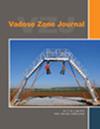格林-安普特模型的简单、准确和显式形式,用于估算渗透率、吸水率和导水率
IF 2.8
3区 地球科学
Q3 ENVIRONMENTAL SCIENCES
引用次数: 0
摘要
半个多世纪以来,人们一直在努力寻找广泛使用的格林-安普特(G-A)一维渗透模型的显式解。我们推导出了一种显式半经验方法,该方法兼具准确性和简便性,而这一概念在以往的研究中普遍被忽视。方程为 ,其中 F (L)、Ks (L/T)、S (L/T0.5) 和 t (T) 分别表示累积渗透率、饱和导水性、吸水率和时间。在当今水利工程面临的大多数应用渗透问题中,应用该方程得出的相对误差 (ɛ) 一般不超过 ±0.3%。我们用数值和数学方法证明,只有当 Kst/F > 0.904 时,│ɛ│> 才可能达到 0.3%,这一标准适用于砂土和壤土(即粗质地),而且它们的渗透率分别超过 6 小时和 19 小时。因此,我们还对模型进行了简单的线性调整,即 Fadj ≅ 0.9796 F + 0.335 S2/Ks,以解决这些较长的渗透率问题,并确保ɛ 保持在预期的 ±0.3% 不确定范围内。我们还开发了一种线性化回归技术,以便在使用 G-A 模型时准确估算 S 和 Ks。我们通过数值证明,只要最初已知毛细管长度 (λ)的实际值,即使 G-A 方法不太有效(扩散性土壤),也可以使用我们的拟合方法。我们这种方法的另一个好处是,通过将 λ 设为 1/3 和 2/3,可以大大限制 S 和 Ks 的初始化、未知、先验值的范围,因为这两个参数是通过隐式渗透模型的逆解估算出来的。由于模型的简洁性和准确性,我们的解决方案可应用于水文学家、自然资源科学家和工程师,他们希望能轻松地从 G-A 渗透方法中得出准确的估算值,和/或估算吸水率和导水率,而不会遇到发散问题。本文章由计算机程序翻译,如有差异,请以英文原文为准。
A simple, accurate, and explicit form of the Green–Ampt model to estimate infiltration, sorptivity, and hydraulic conductivity
Finding an explicit solution to the widely used Green–Ampt (G–A) one‐dimensional infiltration model has been subject of efforts for more than half a century. We derived an explicit semiempirical approach that combines accuracy with simplicity, a concept that has been generally neglected in previous studies. The equation is , with F (L), Ks (L/T), S (L/ T0.5 ) and t (T) being cumulative infiltration, saturated hydraulic conductivity, sorptivity, and time, respectively. Relative errors (ɛ ) by the application of this equation generally do not exceed ±0.3% in most applied infiltration problems faced by water resources engineering today. We show both numerically and mathematically that │ɛ │> 0.3% could only occur if Ks t /F > 0.904, a criterion that could apply to sand and loamy sand soils (i.e., coarse texture) and if they experience infiltration rates for over 6 h and 19 h, respectively. Hence, we also derived a simple linear adjustment in the model as F adj ≅ 0.9796 F + 0.335 S 2 /Ks to address these longer infiltration rates, and to assure that ɛ remains within the expected ±0.3% range of uncertainty. A linearized regression technique was also developed to accurately estimate S and Ks when the G–A model is used. We numerically demonstrated that our fitting method could be used even when the G–A approach is less valid (diffusive soils), provided that the actual value of the capillary length (λ ) is initially known. An added benefit of our approach is that by setting λ equal to 1/3 and 2/3, it can significantly limit the range of initializing, unknown, a priori values of S and Ks , as these two parameters are estimated through the inverse solution of implicit infiltration models. Due to the model's simplicity and accuracy, our solution should find application among hydrologists, natural resource scientists, and engineers who wish to easily derive accurate estimations from the G–A infiltration approach and/or estimate sorptivity and hydraulic conductivity without encountering divergence problems.
求助全文
通过发布文献求助,成功后即可免费获取论文全文。
去求助
来源期刊

Vadose Zone Journal
环境科学-环境科学
CiteScore
5.60
自引率
7.10%
发文量
61
审稿时长
3.8 months
期刊介绍:
Vadose Zone Journal is a unique publication outlet for interdisciplinary research and assessment of the vadose zone, the portion of the Critical Zone that comprises the Earth’s critical living surface down to groundwater. It is a peer-reviewed, international journal publishing reviews, original research, and special sections across a wide range of disciplines. Vadose Zone Journal reports fundamental and applied research from disciplinary and multidisciplinary investigations, including assessment and policy analyses, of the mostly unsaturated zone between the soil surface and the groundwater table. The goal is to disseminate information to facilitate science-based decision-making and sustainable management of the vadose zone. Examples of topic areas suitable for VZJ are variably saturated fluid flow, heat and solute transport in granular and fractured media, flow processes in the capillary fringe at or near the water table, water table management, regional and global climate change impacts on the vadose zone, carbon sequestration, design and performance of waste disposal facilities, long-term stewardship of contaminated sites in the vadose zone, biogeochemical transformation processes, microbial processes in shallow and deep formations, bioremediation, and the fate and transport of radionuclides, inorganic and organic chemicals, colloids, viruses, and microorganisms. Articles in VZJ also address yet-to-be-resolved issues, such as how to quantify heterogeneity of subsurface processes and properties, and how to couple physical, chemical, and biological processes across a range of spatial scales from the molecular to the global.
 求助内容:
求助内容: 应助结果提醒方式:
应助结果提醒方式:


